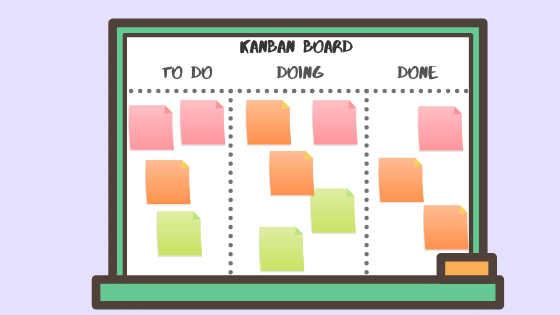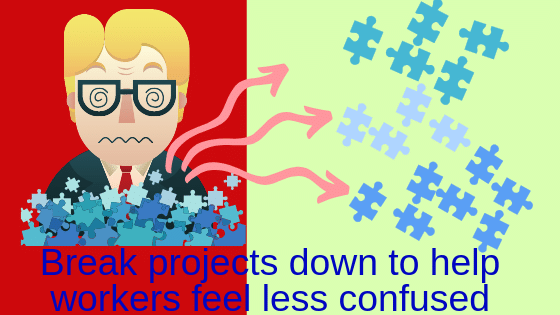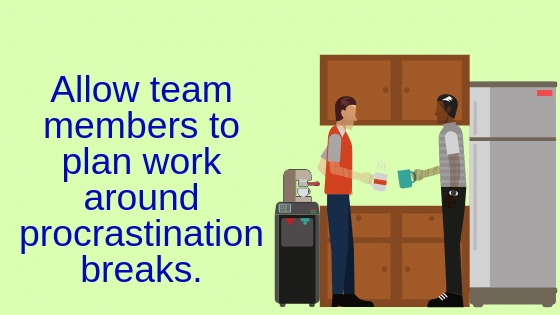Grammar topics in this article (with links to explanations)
This article has examples of the following grammar structures, you can click the links below to learn more about these grammar topics. Or browse our grammar index.
verb patterns: (link)
- stop + ING
- Help + somebody + infinitive
- 3 verbs in one sentence!
- Fail to finish
- Preposition + ING →
- without considering
- It helps by taking away
- Put off + finishing/starting (phrasal verbs: https://breakintoenglish.com/blog/how-to-learn-english/introduction-to-phrasal-verbs/)
- Team members need to be aware
- Nobody enjoys feeling
- recommend + allowing
- allow teams to brainstorm
Conditional sentences
Inversion for emphasis
- Not only …but also…
Will: (link)
- Keeping deadlines short and hard will work
Passive causative
- get their work done
Examples of these grammar structures are marked with an asterisk * within the text
Vocabulary glossary for difficult words contained in this article
Here is a list of difficult words that you may not know the meaning of. Furthermore, in this article I have highlighted the phrasal verbs in bold, do you know the meaning of all of them?
To procrastinate: delay or postpone action; put off doing something.
Cohorts: a group of people with a shared characteristic
Impulsivity: (or impulsiveness) is a tendency to make decisions very quickly without considering the consequences.
To act on a whim: to make a decision very quickly, not taking all factors into account.
The big (or bigger or larger) picture: the situation as a whole.
Actually: in fact (often confused with currently)
Hidey-holes: a place for hiding something or
oneself in, especially as a retreat from other people.
To grind to a halt: slow down so much that you stop
Overwhelmed: a feeling that you cannot cope with all the work.
The reasons for procrastination
According to scientists, the tendency to procrastinate is in our genes, yes, it runs in families and furthermore is linked on a genetic level to impulsivity. Impulsivity (or impulsiveness) is a tendency to act on a whim and make decisions very quickly without considering* the consequences. This genetic predisposition manifests in different ways according to the person and the environment, and your team members may be tempted to procrastinate for several reasons:
- Some workers are choosing pleasure over discipline,
- Other procrastinators want to avoid something negative,
- Many people feel paralyzed by overwhelming expectations.
Help employees stop procrastinating in the workplace
So bearing this in mind, we are going to look at situations where employees *put off finishing or even starting their tasks and then consider solutions for each situation.
1. The task isn’t urgent.

It is hard to ignore a flagged email, a deadline on a calendar or a slack message addressed personally to you, this is because in general, we pay attention to what is right in front of us.
However, it is a lot harder for an office worker to prioritise tasks that aren’t urgent. Actually, this way of focusing on tasks has some evolutionary significance. The human brain is wired to consider our present needs much more strongly than our future needs and there is even a scientific term for the phenomenon: temporal discounting. So we need a remedy for teams with one or more members who have trouble prioritizing.
Solution: Help them see the big picture.
It can be very useful for your team to use a Kanban board to show progress within a project.
Kanban (看板) means signboard or billboard in Japanese and is a scheduling system for lean manufacturing and just-in-time manufacturing (JIT).
*If you break projects down into smaller tasks that can be written on sticky-notes, it can help all members of the team take on a broader perspective. On a kanban board these sticky-notes are displayed in three columns: To do, doing and done.
Solution 2: prioritise tasks to help stop procrastinating
As team-leader or manager you should assign priorities to the tasks and consider how long each task should take to complete. It is very simple to see the big picture using this type of system, and in daily meetings you can discuss the progress of each task with your team. *If a sticky-note is not progressing across the columns on the kanban board, you should identify the reason for this. Team members need to be aware that their task maybe holding up other tasks and Kanban is a great way to illustrate that!
2. Workers don’t know how to start or what comes next.

Sometimes office workers find themselves procrastinating because they don’t know where to start. Consider that they may feel overwhelmed, confused, or disorganized. They may put off getting started because they are not sure what the first step is. Rather than being an avoidance of the task, this kind of procrastination is more avoidance of a negative emotion.
*Nobody enjoys feeling incompetent or clueless, so who can blame workers for organising files on their desktop or doing some other non-related task instead. Indeed, when people put off the task at hand by doing other chores, it’s called productive procrastination.
Solution: Impose structure and accountability.
Again the kanban system is a really useful part of this solution. It helps *by taking away the hidey holes and making sure it’s clear who should be doing what. Tracking accountability in the most public way possible like this helps stop employees procrastinating in the workplace.
It is important that you acknowledge that it’s totally normal for employees to feel overwhelmed or stupid when they are just starting out. Especially if they have never done this type of task before. As we said before, you should break down projects into smaller and smaller tasks, you don’t have to do this yourself. If you don’t have time for this, you should make it clear to your team members that their first task is to figure out what the smallest sub-tasks are and that they need to prioritise those tasks themselves. Furthermore, embrace the initial feeling of insecurity, *allow teams to brainstorm together or to create mind maps – whatever you think will help to keep them focused.
3. Fear of failure.

Provide training and support for procrastinators
*Not only is procrastination connected with impulsiveness, but also with perfectionism. However it is not necessarily high standards that slow workers down, but more a mix of high standards and a belief that attaining these standards is connected to self-worth. This fear of failing leads many workers to actually grind to a halt, blowing off projects, convinced that there’s no way they can meet the standards they have set for themselves.
Solution: Play to strength.
Bearing this in mind, we can see that often, a challenge, is the last thing that procrastinators want. So, whenever possible, assign tasks that they know they can do. And when you can’t, explain why you’re sure that they do a great job. As their manager, make sure that you provide adequate training and support for your procrastination-prone team members so that they don’t feel they are being left alone.
4. Some people stop procrastinating when put under pressure.
Do you remember at school or university there was that kid who could crack open the textbook for the first time a few days before the final exam and still get a better grade than those of us who planned ahead and stuck to a study schedule?
Well, it would seem that those kids were actually planning ahead, just not in the same way. Apparently, there are two types of procrastination: passive and active. Passive procrastination is what we typically think of as procrastination: getting lost in a vortex of youtube videos of cats getting scared by cucumbers or allowing yourself to be distracted by Netflix and the hooks at the end of each episode. All to the detriment of our performance.
Active procrastination in the workplace
Active procrastination, however, is more strategic. There are some people who actually work better under pressure. Perhaps they prefer the adrenaline rush and intense focus associated with a tight deadline. According to a 2017 study from Switzerland, passive procrastination negatively affects students’ grades, but on the other hand, active procrastinators’ grades turn out just fine.
Solution: Understand your workforce
Know your procrastinators, in fact, a good manager should make an effort to get to know all of her team! Here are some tests that you can try: https://www.16personalities.com/free-personality-test and https://www.verywellmind.com/quiz-are-you-a-procrastinator-2795418. Once you have more information about what type of personality your team members have, you can work on your management strategy.
Solution 2: keep deadlines short
* Keeping deadlines short and hard will work for both active and passive procrastinators. So, when you’ve identified procrastinators in your team, give them hard deadlines for their work. Again, if the task or project is a long-term one, break the work down and assign deadlines for each small, manageable task.
Solution 3: offer flexibility and rewards for finishing projects
Also, it is worth bearing in mind that different people work well at different times of the day – so offering flexible working hours can lead to a sense of motivation. Another idea you could consider is relaxing the office hours to mean that when a project or a task is finished, workers can leave early. These ideas can all help employees to stop procrastinating and *get their work done!
5. Sometimes team members just don’t want to do the work.

Allow time for procrastination and subsequent compensation
I’m sure all managers can identify with that Friday feeling – when your mind is elsewhere and you’d rather be doing anything else.
There are some tasks that no one wants to do (even the non-procrastinators in your team) such as filling out that boring form or changing the spelling of that one incorrect word on a single page. A study in the European Journal of Personality found something quite interesting. They reported that some procrastinating people actually plan for procrastination. In their minds, these people weren’t blowing off their work — they fully intended to finish the task, but just not at this point in time.
Solution: Allow time for procrastination and subsequent compensation.
So in the same way that active procrastinators know themselves well, and prefer to work to a deadline, there is a solution for this type of procrastination in the workplace too. The study found that this type of procrastinator know that they like to get distracted, they actually plan to get distracted – so start working on tasks earlier. So in the office world, how can we manage this type of person? Kanban actually allows workers to choose a task that they want to work on, this takes away the excuse that they find the task dull – because they can choose the stick-note that they like best! Furthermore, giving employees the freedom to plan time for a distraction – such as popping to the cafe for a snack or chatting with a colleague about non-work related things – can help this type of procrastinating employees. What? I hear you scream! You would recommend allowing workers to waste time like this? Well yes. It can be very motivating for workers to feel that they are trusted by their managers. The freedom to manage their time is also very encouraging. So yes. Sometimes you have to accept that people procrastinate, and that’s OK, as long as they plan for it in advance.
Conclusion to stop procrastinating in the workplace:
In summary, if you want to help employees stop procrastinating in the workplace, look at the big picture, understand that they may feel overwhelmed, and plan to break tasks down into smaller pieces. Use a kanban board to impose structure and accountability. Allow employees to work with their tendency to procrastinate as it is, not as you wish it to be.

Elizabeth Drayton
Teacher trainer and manager
Our teacher trainer and manager thoughtfully wrote this article in between procrastination breaks. A self-confessed procrastinator, Elizabeth enjoys finding ways to motivate and bring the best out in all of our native teachers here at Break into English.








